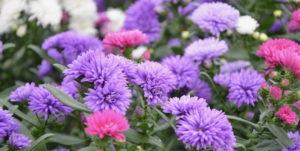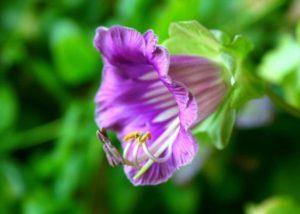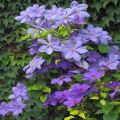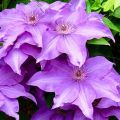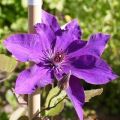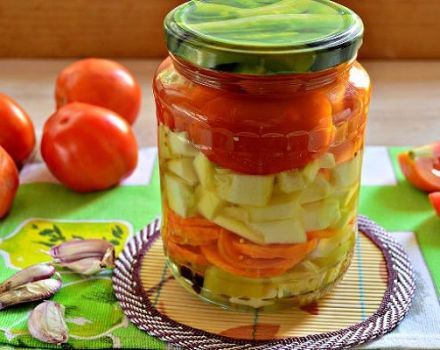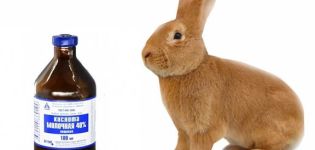Description and group of pruning of clematis varieties Taiga, planting and care
Beautiful clematis bushes have long been one of the main decorations of garden and backyard plots. Thanks to the constant work of breeders, many different varieties and subspecies of these unusual flowers have been bred.
A special place among hybrid plants is occupied by terry varieties of garden culture. It is to this type of plant that the new flower, bred by Japanese scientists, belongs to the clematis of the Taiga variety.
Description and features
Climbing vines, clematis taiga, belong to perennial plants of the buttercup family. The flower is distinguished by its rapid growth and long flowering period. Flexible bushes grow up to 2.5 m in height and up to 1 m in width.
Leaf plates of rich green shades, even and smooth. Thin antennae grow on the leaves, with the help of which the plant is fixed on any surfaces.
Large buds open with huge flowers from 12 to 15 cm in diameter. The active flowering period begins in early summer and ends only in September. Clematis blooms in several stages. First, the main purple flower opens, then the terry middle, lilac and blue shades, with yellow tips, opens up. The bright yellow core of the flower blooms last.
Important! In the process of flowering, clematis changes the color of the inflorescence, which significantly increases its decorative qualities.
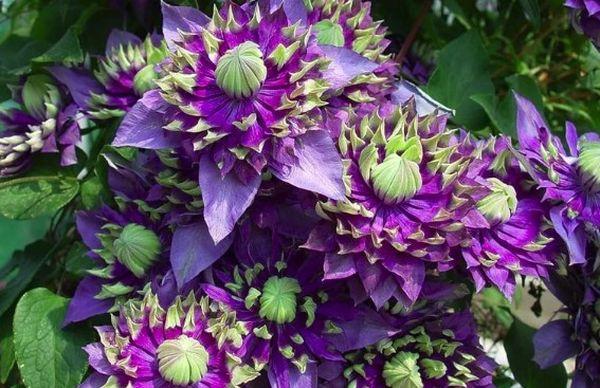
Advantages and disadvantages of the variety
In order to properly grow a unique flower, you need to know about its advantages and disadvantages.
Taiga's advantages:
- Due to the unique structure of the terry inflorescence, Taiga clematis blooms throughout the summer.
- The compact size of the plant allows you to grow it even in small areas.
- The flower tolerates temperature extremes and winter frosts of a temperate climatic zone.
Among the shortcomings of the flower, it is worth noting a weak resistance to diseases and pests, and intolerance to heavily shaded areas.
Planting and leaving
Proper care of a garden flower will not cause difficulties even for a novice florist or gardener. The main requirement for the growth of a flower is a reliable support to which it must cling.
Timing
The timing of planting a plant in open ground depends on the climatic characteristics of the region. Usually, the flower is planted in mid-spring or autumn.
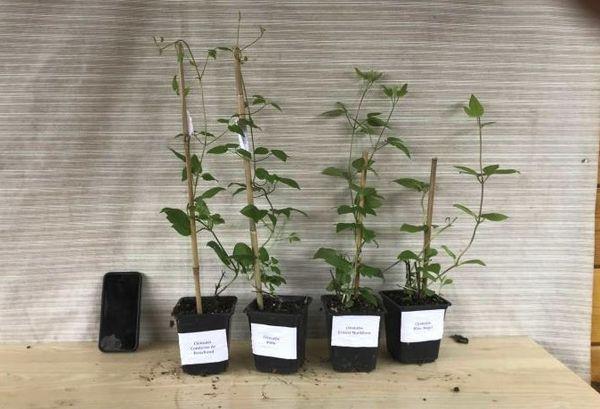
When carrying out work in the autumn, the seedlings of the plant should have several buds.In the spring, the flower is planted in open ground as soon as several shoots are formed.
Site requirements
Clematis Taiga, although it is considered frost-resistant, but for growth and abundant flowering, the plant requires well-lit areas and flower beds with little shading. In areas where groundwater is close, the garden culture will quickly die due to decay of the root system. Also, flowers do not tolerate strong winds and drafts.
Soil selection and preparation
Fertile, well-moistened soils with a low acid content are most suitable for planting clematis.
In well-loosened soil, dig holes, at least 60 cm deep and wide. The soil from the holes is mixed with humus, peat, mineral fertilizers and sand.
Important! In order to prevent moisture from stagnating in the pits, additional drainage from small stones or rubble is made at the bottom of the hole.
Support
Clematis bushes have the structure of vines, therefore, for growth and development, they need additional support.
Young shoots that are in the stage of active growth and can break from a strong gust of wind require especially careful attention.
Large trees, various arches, fences, gazebos, walls and screens are used for support.
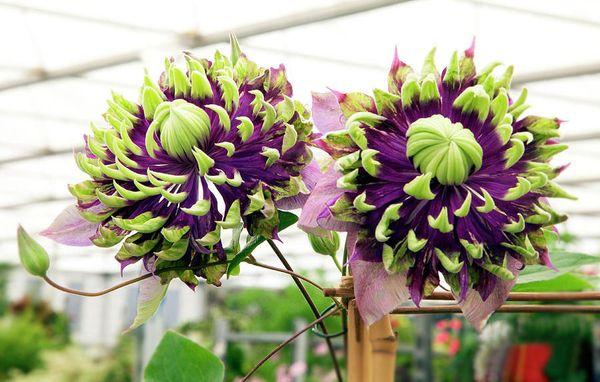
Landing scheme
The plant is perennial, therefore, when planting seedlings, the size and width of an adult bush are taken into account. Before planting in open ground, the planting material is lowered into settled, warm water for 20-30 minutes.
- The distance between the seedlings is at least 1.5 m.
- From fences and walls, plants are planted at a distance of 30 to 50 cm.
- Part of the prepared fertile soil is poured into the hole.
- The seedling is planted in a hole, sprinkled with the remaining soil and watered thoroughly.
Planting flowers too close to each other will deplete the soil and inhibit the growth and development of the bushes.
Care rules
To grow beautiful and healthy flowers, it is enough to follow the simplest agrotechnical rules, which include: timely watering, pruning and feeding of plants.
Watering
Clematis are moisture-loving flowers, especially in need of watering during hot and dry seasons. In the process of watering, not only the rhizomes of flowers are moistened, but also the leaf cover. In the summer heat, irrigation activities are carried out every other day.
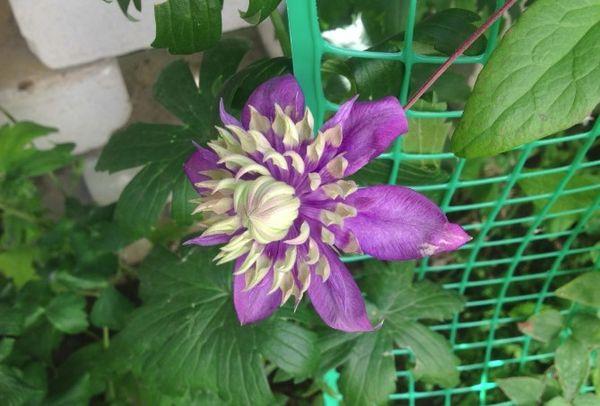
Young bushes are especially demanding on moisture, in which the root system is actively developing. Up to 3 buckets of water are poured under each plant during watering. Lack of moisture provokes a slowdown in growth and a decrease in inflorescences.
Top dressing
Starting from the second year of growth, the garden culture needs additional feeding, which is carried out in spring and autumn.
In order for the bushes to grow quickly and bloom profusely, mineral and organic fertilizers are used.
Important! Mullein and chicken droppings are not recommended for feeding clematis.
Mulching and loosening
Loosening of the soil is carried out as needed. An indicator that a plant requires soil cultivation is the appearance of weeds and a dry crust on the soil surface.
Mulching the soil with sawdust or needles in the autumn prevents the plant's root system from freezing. In spring and summer, events are held to protect the rhizomes from overheating.
Preparation for wintering
Clematis easily survive the temperate winters. Usually, measures for deep mulching of soil and snowdrifts are enough to keep clematis from freezing. In the northern regions, where the average winter temperature drops below -20 degrees, flowers need to be additionally insulated.

For this, the bushes are sprinkled with dry foliage mixed with foam crumbs. The plant is covered with a wooden container, which is wrapped in foil and covered with soil. At the first spring thaws, the shelter is removed.
Protection against diseases and pests
The main enemy for clematis are fungal diseases that affect plants due to waterlogging of the air and soil.
Fusarium
Proper care of the plant reduces the risk of developing fusarium many times. For the prevention of disease, in spring and autumn, plants and soil are treated with special professional preparations.
Withering
Withering is also a fungal disease. The disease manifests itself at the very beginning of the vegetative period. The plant's rhizomes are damaged, so the bush dries up and withers. In case of severe damage, the diseased flower is dug up and burned, and the soil and neighboring plants are treated with chemicals.
Aphid
To protect clematis from aphids, preventive measures are taken every spring. Mineral fertilizers are added to the soil, which include ammonia.
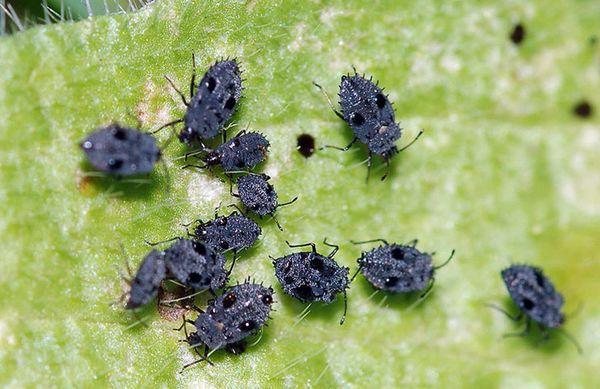
Medvedka
This pest is especially dangerous to young shoots of clematis. Medvedka can completely damage the root system and destroy the plant. To combat this pest, there are both traditional methods and professional, chemical preparations.
Spider mite
A plant prone to attack by a spider mite begins to lose its color and dry out. To combat this pest, professional products are used, which can be purchased at garden centers and flower shops.
Nematodes
The first sign of a nematode infection of a flower is the cessation of plant growth and development. Unfortunately, this pest is very difficult to get rid of, and the plants quickly die out. The main preventive measure against nematodes is the inspection of seedlings when buying and processing the root system of seedlings before planting in open ground.

Trimming group
Every autumn, before the winter rest, Taiga clematis are pruned. Different varieties of flowers belong to a specific pruning group, which differs in the height of the shoots left.
Taiga belongs to the third type of plant that undergoes deep pruning. Dried shoots are cut completely, the rest of the flower is cut to a size of 40-50 cm above the ground surface. The remaining shoots are left with 2-4 vegetative buds.
Reproduction
To increase the number of beautiful flowers in your garden or on your personal plot, clematis are propagated. There are several ways to do this. But which one to choose, each grower must decide independently.
Dividing the bush
Plants that have reached 5 years of age can be separated. To do this, a bush with clematis is undermined on one side, and the shoot is cut off with a sharp knife along with the rhizome.
Cuttings
Propagation by cuttings is the easiest way to quickly propagate beautiful flowers.
- In mature plants, medium branches are cut before the beginning of the flowering period.
- The cuttings are treated with special preparations that accelerate the growth and development of the root system.
- Plants are planted in containers filled with fertile soil. Peat mixed with sand is perfect.
- The cuttings are watered and plucked with a film or glass jar.
- In open ground, seedlings are planted in the spring.
Important! Containers with seedlings should be in a bright place, but not exposed to direct sunlight.
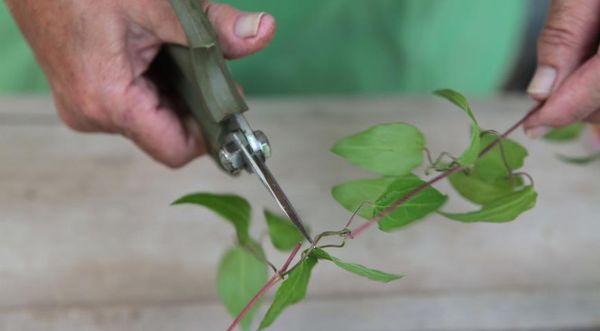
Layers
Reproduction by layering is a laborious process, but as a result, gardeners get strong, healthy seedlings.
- Long harrows are dug around the plant, up to 10 cm deep.
- Shoots of clematis are laid in the dug holes and gently pressed to the ground.
- Sprinkle the shoot with soil, leaving 4-6 cm of the upper part of the plant above the soil surface.
- Layers are moistened, and if necessary, fed.
- In the spring, the shoot is dug up and cut from the mother plant along with the resulting rhizomes.
In regions with a temperate and southern climate, this procedure is carried out in the fall.But in northern latitudes, reproduction by layering is preferable in the spring or at the beginning of the summer period.
